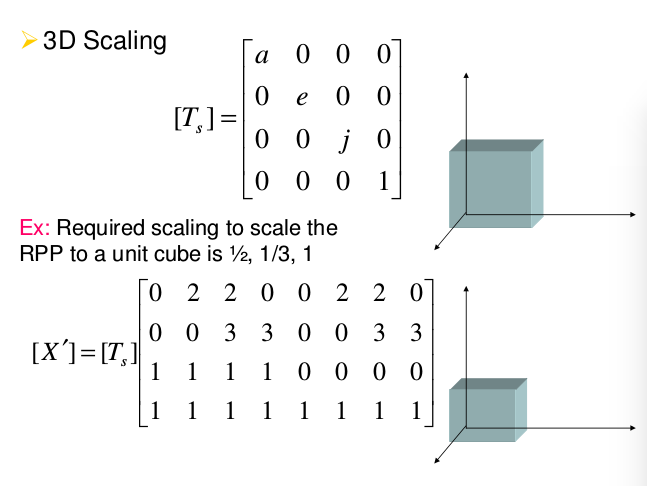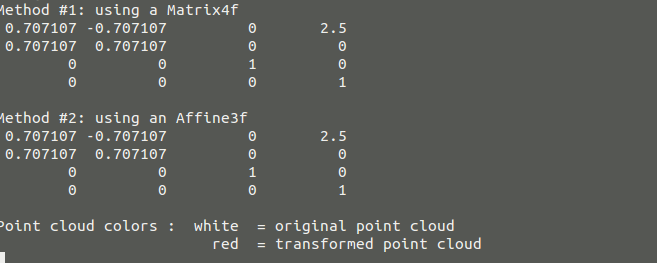PCL点云变换与移除NaN
对点云的操作可以直接应用变换矩阵,即旋转,平移,尺度,3D的变换就是要使用4*4 的矩阵,例如:




等等模型
在这里直接使用程序开实现一个点云的旋转,新建文件matrix.cpp
#include <iostream> #include <pcl/io/pcd_io.h>
#include <pcl/io/ply_io.h>
#include <pcl/point_cloud.h>
#include <pcl/console/parse.h>
#include <pcl/common/transforms.h>
#include <pcl/visualization/pcl_visualizer.h>
// 命令行的帮助提示
void showHelp(char * program_name)
{
std::cout << std::endl;
std::cout << "Usage: " << program_name << " cloud_filename.[pcd|ply]" << std::endl;
std::cout << "-h: Show this help." << std::endl;
} int main (int argc, char** argv)
{
if (pcl::console::find_switch (argc, argv, "-h") || pcl::console::find_switch (argc, argv, "--help")) {
showHelp (argv[]);
return ;
}
// 读取文件
std::vector<int> filenames;
bool file_is_pcd = false;
filenames = pcl::console::parse_file_extension_argument (argc, argv, ".ply");
if (filenames.size () != ) {
filenames = pcl::console::parse_file_extension_argument (argc, argv, ".pcd");
if (filenames.size () != ) {
showHelp (argv[]);
return -;
} else {
file_is_pcd = true;
}
}
//载入文件
pcl::PointCloud<pcl::PointXYZ>::Ptr source_cloud (new pcl::PointCloud<pcl::PointXYZ> ()); if (file_is_pcd) {
if (pcl::io::loadPCDFile (argv[filenames[]], *source_cloud) < ) {
std::cout << "Error loading point cloud " << argv[filenames[]] << std::endl << std::endl;
showHelp (argv[]);
return -;
}
} else {
if (pcl::io::loadPLYFile (argv[filenames[]], *source_cloud) < ) {
std::cout << "Error loading point cloud " << argv[filenames[]] << std::endl << std::endl;
showHelp (argv[]);
return -;
}
} /* Reminder: how transformation matrices work : |-------> This column is the translation
| 1 0 0 x | \
| 0 1 0 y | }-> The identity 3x3 matrix (no rotation) on the left
| 0 0 1 z | /
| 0 0 0 1 | -> We do not use this line (and it has to stay 0,0,0,1) METHOD #1: Using a Matrix4f
This is the "manual" method, perfect to understand but error prone !
*/
Eigen::Matrix4f transform_1 = Eigen::Matrix4f::Identity(); // Define a rotation matrix 定义旋转的角度 再有角度计算出旋转矩阵
float theta = M_PI/; // The angle of rotation in radians
transform_1 (,) = cos (theta);
transform_1 (,) = -sin(theta);
transform_1 (,) = sin (theta);
transform_1 (,) = cos (theta);
// (row, column) // Define a translation of 2.5 meters on the x axis.
transform_1 (,) = 2.5;//意思就是在第一行第四个元素的值为2.5,也就是在x轴的平移为2.5 // Print the transformation 打印出这个变换矩阵
printf ("Method #1: using a Matrix4f\n");
std::cout << transform_1 << std::endl; /* METHOD #2: Using a Affine3f 第二种方案
This method is easier and less error prone 更简单的方案
*/
Eigen::Affine3f transform_2 = Eigen::Affine3f::Identity(); // Define a translation of 2.5 meters on the x axis.
transform_2.translation() << 2.5, 0.0, 0.0; // The same rotation matrix as before; theta radians arround Z axis
transform_2.rotate (Eigen::AngleAxisf (theta, Eigen::Vector3f::UnitZ())); // Print the transformation
printf ("\nMethod #2: using an Affine3f\n");
std::cout << transform_2.matrix() << std::endl; // Executing the transformation
pcl::PointCloud<pcl::PointXYZ>::Ptr transformed_cloud (new pcl::PointCloud<pcl::PointXYZ> ());
// 你可以使用 transform_1 或者 transform_2;效果都是一样的
pcl::transformPointCloud (*source_cloud, *transformed_cloud, transform_2); // 可视化的
printf( "\nPoint cloud colors : white = original point cloud\n"
" red = transformed point cloud\n");
pcl::visualization::PCLVisualizer viewer ("Matrix transformation example"); // 为点云设置RGB的值
pcl::visualization::PointCloudColorHandlerCustom<pcl::PointXYZ> source_cloud_color_handler (source_cloud, , , );
// We add the point cloud to the viewer and pass the color handler
viewer.addPointCloud (source_cloud, source_cloud_color_handler, "original_cloud"); pcl::visualization::PointCloudColorHandlerCustom<pcl::PointXYZ> transformed_cloud_color_handler (transformed_cloud, , , ); // Red
viewer.addPointCloud (transformed_cloud, transformed_cloud_color_handler, "transformed_cloud"); viewer.addCoordinateSystem (1.0, );
viewer.setBackgroundColor(0.05, 0.05, 0.05, ); //设置背景颜色
viewer.setPointCloudRenderingProperties (pcl::visualization::PCL_VISUALIZER_POINT_SIZE, , "original_cloud");
viewer.setPointCloudRenderingProperties (pcl::visualization::PCL_VISUALIZER_POINT_SIZE, , "transformed_cloud");
//viewer.setPosition(800, 400); // Setting visualiser window position while (!viewer.wasStopped ()) { // Display the visualiser until 'q' key is pressed
viewer.spinOnce ();
} return ;
}
编译后我们随便找一个PCD文件查看效果,也可以该程序的参数,查看不同的参数的结果
命令窗口打印的结果

可视化的结果

(2)移除 NaNs:
从传感器获得的点云可能包含几种测量误差和/或不准确。其中之一是在一些点的坐标中存在NaN(不是数)值,正如你在下面的文件中看到的那样:
# .PCD v0.7 - Point Cloud Data file format
VERSION 0.7
FIELDS x y z rgba
SIZE 4 4 4 4
TYPE F F F U
COUNT 1 1 1 1
WIDTH 640
HEIGHT 480
VIEWPOINT 0 0 0 1 0 0 0
POINTS 307200
DATA ascii
nan nan nan 10135463
nan nan nan 10398635
nan nan nan 10070692
nan nan nan 10268071
...
点云对象的成员函数有称为“is_dense()”,如果所有的点都有效的返回true是为有限值。一个NaNs表明测量传感器距离到该点的距离值是有问题的,可能是因为传感器太近或太远,或者因为表面反射。那么当存在无效点云的NaNs值作为算法的输入的时候,可能会引起很多问题,比如“"Assertion `point_representation_->isValid (point) && "Invalid (NaN, Inf) point coordinates given to radiusSearch!"' failed."”如果发生这样的错误就要移除这些点,那么下面就是为了解决移除无效点的程序
#include <pcl/io/pcd_io.h>
#include <pcl/filters/filter.h>
#include <iostream>
#include <pcl/visualization/cloud_viewer.h> int main(int argc,char** argv)
{
if(argc !=)
{
std::cout <<"\tUsage: "<<argv[] <<"<input cloud> <output cloud>" <<std::endl; return -;
} //object for string the point cloud
pcl::PointCloud<pcl::PointXYZRGBA>::Ptr cloud(new pcl::PointCloud<pcl::PointXYZRGBA>);
//read a PCDfile from disk
if(pcl::io::loadPCDFile<pcl::PointXYZRGBA>(argv[],*cloud) !=)
{
return -;
} //the mapping tells you to that points of the oldcloud the new ones correspond
//but we will not use it
std::vector<int> mapping;
pcl::removeNaNFromPointCloud(*cloud, *cloud, mapping);
//pcl::removeNaNFromPointCloud(*cloud, *cloud, mapping);
//save it back
pcl::io::savePCDFileASCII(argv[],*cloud); pcl::visualization::CloudViewer viewer(argv[]);
viewer.showCloud(cloud);
while (!viewer.wasStopped())
{
// Do nothing but wait.
} }
然后可以显示移除NaNs点后的可视图,

这张点云是我自己用kinect 生成的点云,在没有移除NaNs的时候可以先读取以下,显示他的点云数值在命令窗口,你会发现会有很多的NaNs的无效点,经过
移除这些点之后在read一些打印处的结果就不会存在NaNs的无效点,这样在后期的使用算法的时候就不会出现错误了。

这种方法的问题是它不会保持点云仍然是有序点云。所有的点云都存储一个“宽度”和“高度”变量。在无序点云,总数为宽度相同,而高度设置为1。在有序的点云(像从相机拍摄像传感器如Kinect或Xtion的),宽度和高度都相同的像素的图像分辨率传感器的工作。点云分布在深度图像的行中,每一个点对应一个像素。成员函数”isorganized()”如果高度大于1时返回真。
由于移除NaNs无效点会改变点云的点的数量,它不再能保持组织与原来的宽高比,所以函数将设置高度1。这不是一个大问题,只有少数的PCL的算法工作明确要求是有序的点云(大多这样情况下会使用在优化上),但你必须考虑其中的影响。
暂时就到这里了。。。。。。
微信公众号号可扫描二维码一起共同学习交流

PCL点云变换与移除NaN的更多相关文章
- PCL点云配准(1)
在逆向工程,计算机视觉,文物数字化等领域中,由于点云的不完整,旋转错位,平移错位等,使得要得到的完整的点云就需要对局部点云进行配准,为了得到被测物体的完整数据模型,需要确定一个合适的坐标系,将从各个视 ...
- PCL点云库:ICP算法
ICP(Iterative Closest Point迭代最近点)算法是一种点集对点集配准方法.在VTK.PCL.MRPT.MeshLab等C++库或软件中都有实现,可以参见维基百科中的ICP Alg ...
- PCL点云配准(2)
(1)正态分布变换进行配准(normal Distributions Transform) 介绍关于如何使用正态分布算法来确定两个大型点云之间的刚体变换,正态分布变换算法是一个配准算法,它应用于三维点 ...
- PCL中点云数据格式之间的转化
(1) 关于pcl::PCLPointCloud2::Ptr和pcl::PointCloud<pcl::PointXYZ>两中数据结构的区别 pcl::PointXYZ::PointXYZ ...
- PCL点云库中的坐标系(CoordinateSystem)
博客转载自:https://blog.csdn.net/qq_33624918/article/details/80488590 引言 世上本没有坐标系,用的人多了,便定义了坐标系统用来定位.地理坐标 ...
- Windows下安装PCL点云库
原文链接:http://blog.csdn.net/u012337034/article/details/38270109 简介: 在Windows下安装PCL点云库的方法大概有两种: ...
- Windows 8 64位系统 在VS2010 32位软件上 搭建 PCL点云库 开发环境
Windows 8 64位系统 在VS2010 32位软件上 搭建 PCL点云库 开发环境 下载PCL For windows 软件包 到这个网站下载PCL-All-In-One Installer: ...
- PCL学习之:将超声数据按照PCL点云方式发布出去
前言:基于2D激光雷达的机器人,想让它跑自动导航,众所周知有2个比较明显的缺陷,1,那就是普通的激光雷达无法对玻璃或是镜面物体有反映; 2,机器人避障时只能对某一个平面的物体有反映,超过或者低于这个平 ...
- PCL点云库:对点云进行变换(Using a matrix to transform a point cloud)
点云数据可以用ASCII码的形式存储在PCD文件中(关于该格式的描述可以参考链接:The PCD (Point Cloud Data) file format).为了生成三维点云数据,在excel中用 ...
随机推荐
- Django form入门详解--1
form在django中的作用: 1.可以用于自动生成form的html 2.数据校验 3.与model一在一起使用.可以大的方便数据驱动型网站的开发 编程中有许多的东西是“不可描述”的.只有动手去 ...
- Android 如何在Eclipse 引入外部纯Java项目(不是打成Jar使用)
应用情景--如标题: 在Eclipse的 “Android启动项目”中引入“外部的纯Java项目”,能运行的只有是基于Android的测试代码才可以. 一直很纳闷,如果外部写好一个Java插件(例如服 ...
- 【Unity】6.2 在VS2015中调试 C# 脚本
分类:Unity.C#.VS2015 创建日期:2016-04-16 一.简介 这一节先利用GUI显示一个简单的界面(以后还会专门介绍GUI),并解释如何在VS2015中调试C#脚本. 本节例子的运行 ...
- windows远程连接mac配置方法
1.开启mac共享服务,设置通过密码进行连接 [系统偏好设置]中选择[共享]打开[屏幕共享]服务,即可允许其他电脑的用户远程查看并控制此电脑.点击[电脑设置]配置访问密码 2. 下载TightVNC, ...
- [AWS vs Azure] 云计算里AWS和Azure的探究(5) ——EC2和Azure VM磁盘性能分析
云计算里AWS和Azure的探究(5) ——EC2和Azure VM磁盘性能分析 在虚拟机创建完成之后,CPU和内存的配置等等基本上是一目了然的.如果不考虑显卡性能,一台机器最重要的性能瓶颈就是硬盘. ...
- [Windows Azure] Adding Sign-On to Your Web Application Using Windows Azure AD
Adding Sign-On to Your Web Application Using Windows Azure AD 14 out of 19 rated this helpful - Rate ...
- Delphi下IOCP开源框架:DIOCP 成功应用案例分享
首先说明,该项目不是本人的项目,本文转自盒子. 该项目使用的DIOCP版本为1.0,目前diocp为3.5 以下是盒子的原文 ------------------------------------- ...
- audio音乐播放
1.audio标签 <audio @play="ready" @error="error" ref="audio" :src=&quo ...
- 【转】MySQL查看表占用空间大小(转)
//先进去MySQL自带管理库:information_schema //自己的数据库:rokid_cas_music_test //自己的表:data_song_thirdparty mysql&g ...
- 利用order by 进行盲注
0x01 利用场景 登录代码: $username = $_POST['username']; $password = $_POST['password']; if(filter($username) ...
